Types Of Scorpions In Arkansas
Scorpions are fascinating animals known for their long tails with a stinger at the end. Despite looking similar small-scale land lobsters with big pincers, they are arachnids closely related to spiders. There are various species of scorpions in Arizona, including 1 of the most venomous ones establish in North America.
Arizona has 3 major deserts that are optimal habitats for scorpions: the Chihuahuan, Mojave, and Sonoran. With the Sonoran being and so massive, information technology takes up virtually of the central and southwest parts of the state. Although scorpions tend to stay in their natural environments, you lot can likewise observe them wandering up plumping and into homes at dark. However, you tin easily rail them out since they glow fluorescent bluish under ultraviolet light (UV).
x Species of Scorpions in Arizona
In that location are 40 to lx species of scorpions in Arizona and in this article, nosotros will look at ten in more than detail. Let's learn nearly what these species are and how venomous they are to humans.
i. Arizona Bark Scorpion

Scientific name: Centruroides sculpturatus
Size:3 inches
Venomous:Yep
As their name suggests, the Arizona bark scorpions enjoy living in or around tree bark. They tend to alive in rocky desert areas and are normally found in the Grand Canyon, specially by streams. Withal, you can also notice them within homes since they commonly climb vertical surface areas. These scorpions are yellowish-tan with modest pincers and slender, long tails. Some of them can have striped patterns.
This species is the virtually venomous in Northern America. Although by and large not life-threatening, the venom of this species can cause painful swelling, muscle spasms, paralyzed extremities, and animate difficulties. Some people say existence stung feels like an electrocution jolt. Information technology is recommended you seek medical attention immediately.
two. Arizona Giant Hairy Scorpion

Scientific proper name: Hadrurus arizonensis
Size:upwards to vi inches
Venomous:Aye, mild
The Arizona giant hairy scorpion is one of the largest scorpions in the U.S. They boilerplate at 5 inches in length, with some growing bigger, up to 6 inches. Since it is so large, it often eats other scorpions, small mammals, and lizards. Although their sting is deadly to their casualty, it simply causes mild pain for humans.
These scorpions are typically yellowish with a night elevation and chocolate-brown hairs roofing their bodies, giving them their name. You can find them in the Mojave and Sonoran deserts, where they enjoy burrowing into the globe to the moisture line underground. They tin burrow up to viii anxiety deep.
3. Arizona Stripetail Scorpion
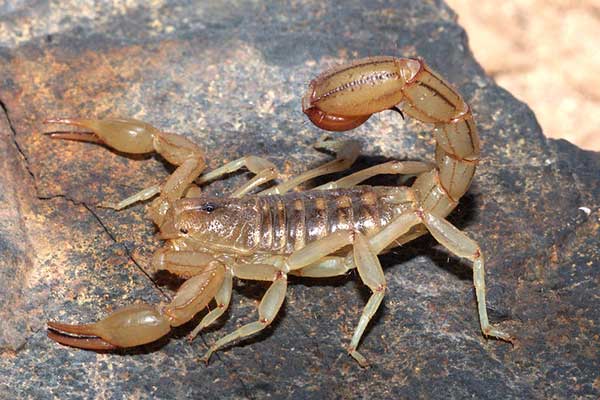
Scientific name: Paravaejovis spinigerus
Size:two inches
Venomous:Yep, mild
The Arizona stripetail scorpion is also sometimes called the devil scorpion. Its venom is far less harmful than most other scorpions. If you become stung, you volition experience a balmy discomfort and information technology's not medically significant. This scorpion is yellowish-tan in color with a thick tail that has brown stripes on it.
Although averaging ii inches in length, females can grow up to two.vii inches. You tin ofttimes observe them living in the Sonoran desert, hiding under rocks or fifty-fifty sleeping numberless. These scorpions are also known to feed on other scorpions found in Arizona.
4. Yellow Ground Scorpion
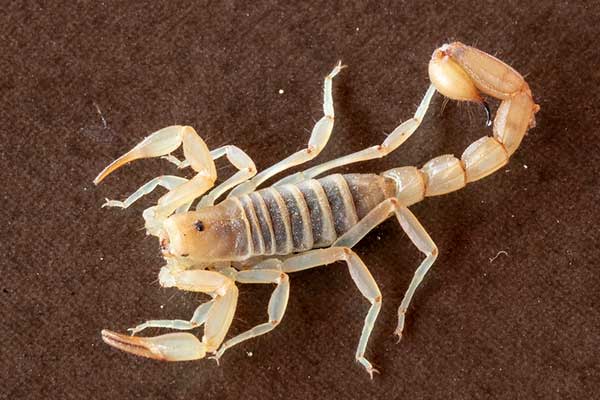
Scientific name: Paravaejovis confusus
Size:two inches
Venomous:Yes
The yellow ground scorpion, likewise known as the yellowish devil scorpion, is stake and yellowish in color and looks similar to the Arizona bark scorpion. The main difference is they take longer and wider abdominal segments. The tips of their pinchers and stingers can also have a ruddy tint. Although their sting is painful, information technology is not considered life-threatening.
These scorpions typically live in southeastern Arizona. You can find them in the desert and high mountain habitats. Even so, they are mainly observed in June and September.
5. Northern Scorpion
Scientific proper name: Paruroctonus boreus
Size:up to 2.16 inches
Venomous:Yes, balmy
The adult Northern Scorpion size ranges between one.37 to two.16 inches. These scorpions are typically blackness, brownish, ivory, or yellow with chocolate-brown-yellow stripes. If yous get stung, it can result in redness, swelling, and pain in the sting area. Nevertheless, with a cold press, the swelling should reduce inside 24 to 72 hours.
Y'all can normally discover these scorpions in mountainous regions and the loftier elevations of Arizona. These scorpions are also very cold-tolerant and one of the merely species you can detect in Canada during the dry flavor.
half dozen. Walnut Gulch Scorpion
Scientific name: Serradigitus miscionei
Size:1 inch
Venomous:Yes, very balmy
The Walnut Gulch scorpion is a rare species that tin merely exist found in southern Arizona. They were recently discovered along the walls of San Pedro River in 2011 and normally live near other rivers in the surface area. Unlike most scorpions that bask the flat desert sands, this species prefers vertical sand surfaces.
These small 1-inch scorpions are carmine, brown and average one inch in length. They casualty mainly on small invertebrates and their venom is not considered medically threatening to humans or pets, such as dogs.
7. Arizona Smoothclaw Scorpion
Scientific name: Diplocentrus spitzeri
Size:up to 2.05 inches
Venomous:Yeah, very mild
You tin observe the Arizona smoothclaw scorpion throughout Arizona, typically at medium elevations. They prefer hiding under bark, rocks, and foliage litter in the daytime. Like most scorpions, they are nocturnal and come up out to hunt at night.
These scorpions generally take a brownish trunk with yellow-brown legs. They grow between 1.57 and ii.05 inches in length.Some people accept reported their stings barely injure, is similar to an ant sting, and the redness at the sting site went abroad later 10 seconds. Although information technology is possible this was merely a warning sting, since scorpions tin can control the amount of venom in their stings.
8. Dune Scorpion
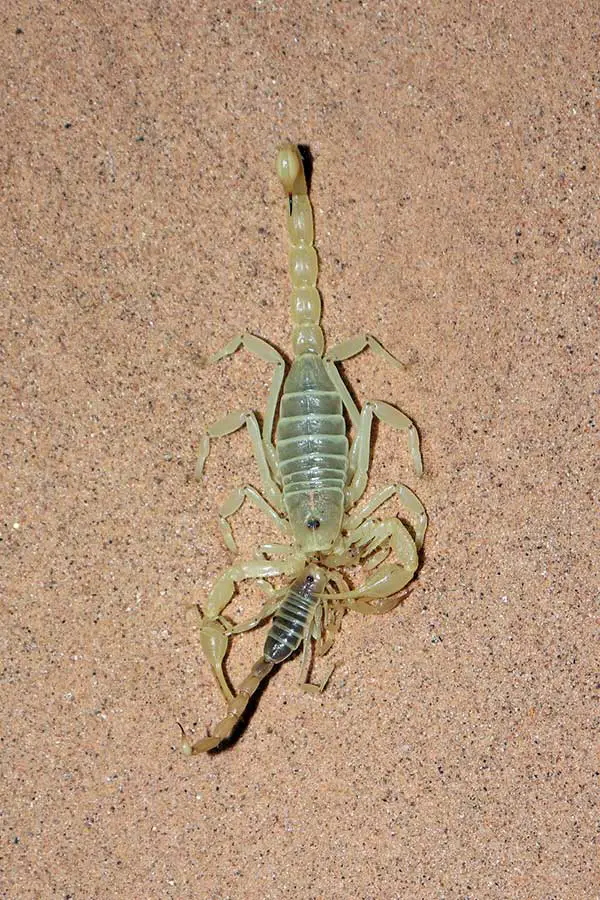
Scientific name: Smeringurus mesaensis
Size: 2.8 inches
Venomous:Aye
The dune scorpion, as well known equally the behemothic sand scorpion, is mostly found in the desert regions. As their name suggests, they adopt habitats with dunes so they can dig into the sediment and sand.
These scorpions average 2.eight inches in length. Females are typically larger than males, still, the males will have larger pinchers. Their colour is typically darker dark-brown-grey. These scorpions will sting you if disturbed or threatened, and so try not to handle them. Their sting is painful and has been compared to hornet stings.
9. Blackness-Back Scorpion
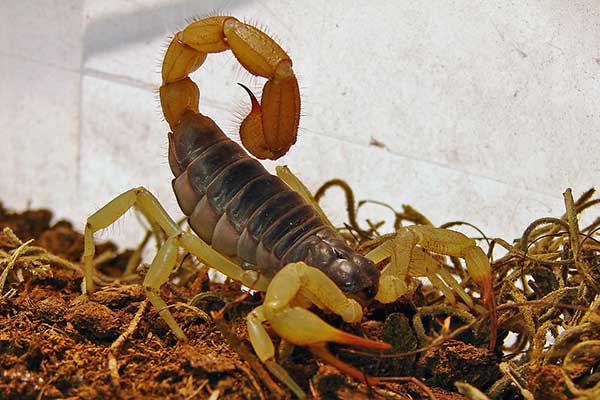
Scientific name: Hadrurus spadix
Size:5 inches
Venomous:Aye, mild
The black-back scorpion is also called the northern desert hairy scorpion and blackness hairy scorpion. As their proper noun suggests, the black-back scorpion has a blackness torso with lighter, yellow extremities. They are large in size, similar to the Arizona behemothic hairy scorpion. All the same, their range extends more north of the U.S.
These scorpions prey on annihilation they can catch. Their big size allows them to swallow other scorpions, mice, snakes, and lizards. They are burrowing scorpions that spend their time in deserts digging in the sand. Although their sting is quite painful, their toxicity to humans is considered low, and they tin make adept pets for beginners.
10. Superstition Mountains Scorpion
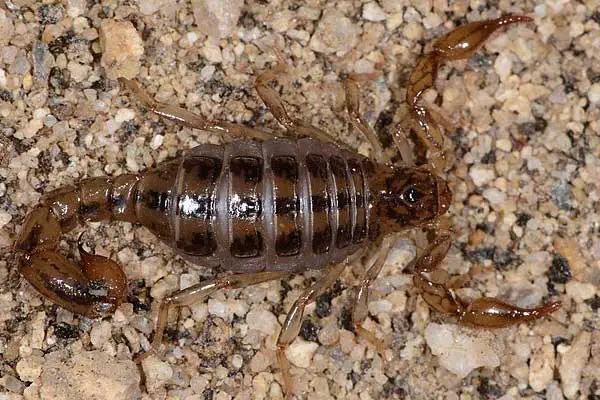
Scientific name: Superstitionia donensis
Size:upward to 1 inch
Venomous:Yes
As their proper name suggests, you can detect this species living in the Superstition Mountains of Arizona. They were start discovered in 1940 and enjoy hiding almost plants or nether rocks in desert habitats. This species is also more often than not cave-dwelling.
These modest scorpions grow up to merely ane inch and don't have lateral eyes. Their bodies are brown and typically lack pigmentation, looking quite shiny in advent. This allows them to live in caves finer. Their venom tin can cause humans pain, redness, and swelling.
Types Of Scorpions In Arkansas,
Source: https://critterhideout.com/scorpions-in-arizona/
Posted by: kentunclefor.blogspot.com


0 Response to "Types Of Scorpions In Arkansas"
Post a Comment